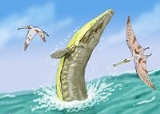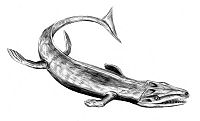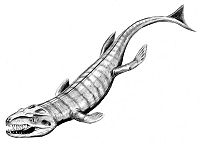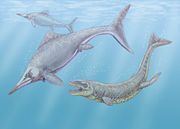
Dakosaurus
Encyclopedia
Dakosaurus is an extinct genus
within the family
Metriorhynchidae
that lived during the Late Jurassic
and Early Cretaceous
. It was large, with teeth that were serrated
and compressed lateromedially (flattened from side to side). The genus was established by Friedrich August von Quenstedt
in 1856 for an isolated tooth named Geosaurus maximus by Plieninger. Dakosaurus was a carnivore
that spent much, if not all, its life out at sea. The extent of its adaptation to a marine lifestyle means that it is most likely that it mated at sea, but since no eggs or nests have been discovered that have been referred to Dakosaurus, whether it gave birth to live young at sea like dolphin
s and ichthyosaur
s or came ashore like turtle
s is not known. The name Dakosaurus means "tearing lizard", and is derived from the Greek
Dakos- ("to tear") and -sauros ("lizard").

 When isolated Dakosaurus teeth were first discovered in Germany
When isolated Dakosaurus teeth were first discovered in Germany
, they were mistaken for belonging to the theropod dinosaur
Megalosaurus
.
Fossil specimens referrable to Dakosaurus are known from Late Jurassic deposits from England
, France
, Switzerland
, Germany, Poland
, Russia
, Argentina
, and Mexico
. Teeth referrable to Dakosaurus are known from Europe from the Oxfordian
.
Dakosaurus maximus, meaning "greatest tearing lizard" is known from fossil
discoveries in Western Europe (England, France, Switzerland and Germany) of the Late Jurassic (Late Kimmeridgian
-Early Tithonian
).
Dakosaurus andiniensis, meaning "tearing lizard from the Andes", was first discovered in 1987 in the Neuquén
Basin, a very rich fossil bed in Argentina. However, it was not until 1996 that the binomen Dakosaurus andiniensis was erected. Two recently discovered skulls have indicated that D. andiniensis is unique among the metriorhynchids (the most specialised family of crocodylians to marine life) with its short, tall snout (which is why it was nicknamed Godzilla
).This species has a fossil range from the End Jurassic-Beginning Cretaceous (Late Tithonian
-Early Berriasian
).
Dakosaurus nicaeensis, named in 1913 by Ambayrac, who mistakenly classified it as a megalosaurid
dinosaur. It was the sole species in the genus Aggiosaurus. Buffetaut in 1982 demonstrated that it was in fact a metriorhynchid, closely related to, if not a member of Dakosaurus. As the type specimen is poorly preserved it is considered nomen dubium
. In 2009, Young and Andrade published a re-description of Geosaurus, examining its relationships and the validity of species lumped into the genus. They concluded that Aggiosaurus must be a junior synonym of Dakosaurus.
of Dakosaurus, although the species D. maximus and D. andiniensis do constite a natural group.
Cladogram
after Cau & Fanti (2011).
The cladogram below follows a subsequent analysis by Young et al. (2011).
s (known from Geosaurus
and Metriorhynchus
) would have been housed. Unfortunately, there was no preservational evidence of the glands themselves.
, early Tithonian) of Bavaria
, Germany. Alongside three other metriorhynchid species, it has been hypothesised that niche partitioning
enabled several species of crocodyliforms to co-exist. Dakosaurus and Geosaurus giganteus would have been top predators of this Formation, both of which were large, short-snouted species with serrated teeth. The remaining two species (Cricosaurus suevicus
and Rhacheosaurus gracilis
, and the teleosaurid Steneosaurus
would have feed mostly on fish.
From the slightly older Nusplingen
Plattenkalk (late Kimmeridgian) of southern Germany, both D. maximus and C. suevicus are contemporaneous. As with Solnhofen, Dakosaurus was the top predator, while C. suevicus was a fish-eater.

.
The enlarged supratemporal fenestrae of Dakosaurus skulls would have anchored large adductor muscle
s (jaw closing), ensuring a powerful bite. As their skulls are triangular in shape, with deeply rooted large, serrated teeth and a bulbous, deep mandibular symphysis (like pliosaur
s), dakosaurs would also have been able to twist feed (tear chunks of flesh of potential prey).
Genus
In biology, a genus is a low-level taxonomic rank used in the biological classification of living and fossil organisms, which is an example of definition by genus and differentia...
within the family
Family (biology)
In biological classification, family is* a taxonomic rank. Other well-known ranks are life, domain, kingdom, phylum, class, order, genus, and species, with family fitting between order and genus. As for the other well-known ranks, there is the option of an immediately lower rank, indicated by the...
Metriorhynchidae
Metriorhynchidae
Metriorhynchidae is an extinct family of metriorhynchoid crocodyliforms from the Middle Jurassic to the Early Cretaceous period of Europe, North America and South America. Metriorhynchids are fully aquatic crocodyliforms. Their forelimbs were small and paddle-like, and unlike living crocodilians,...
that lived during the Late Jurassic
Late Jurassic
The Late Jurassic is the third epoch of the Jurassic Period, and it spans the geologic time from 161.2 ± 4.0 to 145.5 ± 4.0 million years ago , which is preserved in Upper Jurassic strata. In European lithostratigraphy, the name "Malm" indicates rocks of Late Jurassic age...
and Early Cretaceous
Early Cretaceous
The Early Cretaceous or the Lower Cretaceous , is the earlier or lower of the two major divisions of the Cretaceous...
. It was large, with teeth that were serrated
Serrated Edge
Serrated Edge is the second album by Tempest. It was their first with a fiddler, and was released in 1992.-Tracks:#Hal-an Tow #Raggle Taggle Gypsy #A Kiss in the Morning Early...
and compressed lateromedially (flattened from side to side). The genus was established by Friedrich August von Quenstedt
Friedrich August von Quenstedt
Friedrich August von Quenstedt , was a German geologist and palaeontologist.-Life:Von Quenstedt was born at Eisleben in Saxony, and educated at the Humboldt University of Berlin...
in 1856 for an isolated tooth named Geosaurus maximus by Plieninger. Dakosaurus was a carnivore
Carnivore
A carnivore meaning 'meat eater' is an organism that derives its energy and nutrient requirements from a diet consisting mainly or exclusively of animal tissue, whether through predation or scavenging...
that spent much, if not all, its life out at sea. The extent of its adaptation to a marine lifestyle means that it is most likely that it mated at sea, but since no eggs or nests have been discovered that have been referred to Dakosaurus, whether it gave birth to live young at sea like dolphin
Dolphin
Dolphins are marine mammals that are closely related to whales and porpoises. There are almost forty species of dolphin in 17 genera. They vary in size from and , up to and . They are found worldwide, mostly in the shallower seas of the continental shelves, and are carnivores, mostly eating...
s and ichthyosaur
Ichthyosaur
Ichthyosaurs were giant marine reptiles that resembled fish and dolphins...
s or came ashore like turtle
Turtle
Turtles are reptiles of the order Testudines , characterised by a special bony or cartilaginous shell developed from their ribs that acts as a shield...
s is not known. The name Dakosaurus means "tearing lizard", and is derived from the Greek
Ancient Greek
Ancient Greek is the stage of the Greek language in the periods spanning the times c. 9th–6th centuries BC, , c. 5th–4th centuries BC , and the c. 3rd century BC – 6th century AD of ancient Greece and the ancient world; being predated in the 2nd millennium BC by Mycenaean Greek...
Dakos- ("to tear") and -sauros ("lizard").
Discovery and species


Germany
Germany , officially the Federal Republic of Germany , is a federal parliamentary republic in Europe. The country consists of 16 states while the capital and largest city is Berlin. Germany covers an area of 357,021 km2 and has a largely temperate seasonal climate...
, they were mistaken for belonging to the theropod dinosaur
Dinosaur
Dinosaurs are a diverse group of animals of the clade and superorder Dinosauria. They were the dominant terrestrial vertebrates for over 160 million years, from the late Triassic period until the end of the Cretaceous , when the Cretaceous–Paleogene extinction event led to the extinction of...
Megalosaurus
Megalosaurus
Megalosaurus is a genus of large meat-eating theropod dinosaurs of the Middle Jurassic period of Europe...
.
Fossil specimens referrable to Dakosaurus are known from Late Jurassic deposits from England
England
England is a country that is part of the United Kingdom. It shares land borders with Scotland to the north and Wales to the west; the Irish Sea is to the north west, the Celtic Sea to the south west, with the North Sea to the east and the English Channel to the south separating it from continental...
, France
France
The French Republic , The French Republic , The French Republic , (commonly known as France , is a unitary semi-presidential republic in Western Europe with several overseas territories and islands located on other continents and in the Indian, Pacific, and Atlantic oceans. Metropolitan France...
, Switzerland
Switzerland
Switzerland name of one of the Swiss cantons. ; ; ; or ), in its full name the Swiss Confederation , is a federal republic consisting of 26 cantons, with Bern as the seat of the federal authorities. The country is situated in Western Europe,Or Central Europe depending on the definition....
, Germany, Poland
Poland
Poland , officially the Republic of Poland , is a country in Central Europe bordered by Germany to the west; the Czech Republic and Slovakia to the south; Ukraine, Belarus and Lithuania to the east; and the Baltic Sea and Kaliningrad Oblast, a Russian exclave, to the north...
, Russia
Russia
Russia or , officially known as both Russia and the Russian Federation , is a country in northern Eurasia. It is a federal semi-presidential republic, comprising 83 federal subjects...
, Argentina
Argentina
Argentina , officially the Argentine Republic , is the second largest country in South America by land area, after Brazil. It is constituted as a federation of 23 provinces and an autonomous city, Buenos Aires...
, and Mexico
Mexico
The United Mexican States , commonly known as Mexico , is a federal constitutional republic in North America. It is bordered on the north by the United States; on the south and west by the Pacific Ocean; on the southeast by Guatemala, Belize, and the Caribbean Sea; and on the east by the Gulf of...
. Teeth referrable to Dakosaurus are known from Europe from the Oxfordian
Oxfordian stage
The Oxfordian is, in the ICS' geologic timescale, the earliest age of the Late Jurassic epoch, or the lowest stage of the Upper Jurassic series. It spans the time between 161.2 ± 4 Ma and 155.7 ± 4 Ma...
.
Valid species
The type speciesType species
In biological nomenclature, a type species is both a concept and a practical system which is used in the classification and nomenclature of animals and plants. The value of a "type species" lies in the fact that it makes clear what is meant by a particular genus name. A type species is the species...
Dakosaurus maximus, meaning "greatest tearing lizard" is known from fossil
Fossil
Fossils are the preserved remains or traces of animals , plants, and other organisms from the remote past...
discoveries in Western Europe (England, France, Switzerland and Germany) of the Late Jurassic (Late Kimmeridgian
Kimmeridgian
In the geologic timescale, the Kimmeridgian is an age or stage in the Late or Upper Jurassic epoch or series. It spans the time between 155.7 ± 4 Ma and 150.8 ± 4 Ma . The Kimmeridgian follows the Oxfordian and precedes the Tithonian....
-Early Tithonian
Tithonian
In the geologic timescale the Tithonian is the latest age of the Late Jurassic epoch or the uppermost stage of the Upper Jurassic series. It spans the time between 150.8 ± 4 Ma and 145.5 ± 4 Ma...
).
Dakosaurus andiniensis, meaning "tearing lizard from the Andes", was first discovered in 1987 in the Neuquén
Neuquén
Neuquén is the name of the following things:* Neuquén, Argentina* Neuquén Province* Neuquén River* Neuquén Group...
Basin, a very rich fossil bed in Argentina. However, it was not until 1996 that the binomen Dakosaurus andiniensis was erected. Two recently discovered skulls have indicated that D. andiniensis is unique among the metriorhynchids (the most specialised family of crocodylians to marine life) with its short, tall snout (which is why it was nicknamed Godzilla
Godzilla
is a daikaijū, a Japanese movie monster, first appearing in Ishirō Honda's 1954 film Godzilla. Since then, Godzilla has gone on to become a worldwide pop culture icon starring in 28 films produced by Toho Co., Ltd. The monster has appeared in numerous other media incarnations including video games,...
).This species has a fossil range from the End Jurassic-Beginning Cretaceous (Late Tithonian
Tithonian
In the geologic timescale the Tithonian is the latest age of the Late Jurassic epoch or the uppermost stage of the Upper Jurassic series. It spans the time between 150.8 ± 4 Ma and 145.5 ± 4 Ma...
-Early Berriasian
Berriasian
In the geological timescale, the Berriasian is an age or stage of the Early or Lower Creteceous. It is the oldest or lowest subdivision in the entire Cretaceous. It spanned between 145.5 ± 4.0 Ma and 140.2 ± 3.0 Ma...
).
Dakosaurus nicaeensis, named in 1913 by Ambayrac, who mistakenly classified it as a megalosaurid
Megalosaurid
Megalosauridae was a family of relatively primitive tetanuran theropod dinosaurs, order Saurischia. They were small-to-large carnivores with sharp teeth and three claws on each hand. Some members of this group were Megalosaurus, Eustreptospondylus, Streptospondylus and Torvosaurus...
dinosaur. It was the sole species in the genus Aggiosaurus. Buffetaut in 1982 demonstrated that it was in fact a metriorhynchid, closely related to, if not a member of Dakosaurus. As the type specimen is poorly preserved it is considered nomen dubium
Nomen dubium
In zoological nomenclature, a nomen dubium is a scientific name that is of unknown or doubtful application...
. In 2009, Young and Andrade published a re-description of Geosaurus, examining its relationships and the validity of species lumped into the genus. They concluded that Aggiosaurus must be a junior synonym of Dakosaurus.
Unnamed species
Incomplete skull specimens of Dakosaurus has been discovered in Kimmeridgian age rocks from Mexico.Taxonomy and phylogeny
The genus Plesiosuchus is a junior synonym of Dakosaurus, while Dacosaurus is a mis-spelling. Recent phylogenetic analysis however, does not support the monophylyMonophyly
In common cladistic usage, a monophyletic group is a taxon which forms a clade, meaning that it contains all the descendants of the possibly hypothetical closest common ancestor of the members of the group. The term is synonymous with the uncommon term holophyly...
of Dakosaurus, although the species D. maximus and D. andiniensis do constite a natural group.
Cladogram
Cladogram
A cladogram is a diagram used in cladistics which shows ancestral relations between organisms, to represent the evolutionary tree of life. Although traditionally such cladograms were generated largely on the basis of morphological characters, DNA and RNA sequencing data and computational...
after Cau & Fanti (2011).
The cladogram below follows a subsequent analysis by Young et al. (2011).
Morphology
All currently known species would have been approximately four to five metres in length, which when compared to living crocodilians, Dakosaurus can be considered large-sized. Its body was streamlined for greater hydrodynamic efficiency, which along with its finned tail made it a more efficient swimmer than modern crocodilian species.Salt glands
The incomplete skull specimens from the Mexican species of Dakosaurus preserves the chamber in which the well-developed salt glandSalt gland
The salt gland is an organ for excreting excess salts. It is found in elasmobranchs, seabirds, and some reptiles. In sharks, salt glands are found in the rectum, but in birds and reptiles, they are found in or on the skull, in the area of the eyes, nostrils or mouth. In crocodiles, the salt is...
s (known from Geosaurus
Geosaurus
Geosaurus is an extinct genus of marine crocodyliform within the family Metriorhynchidae that lived during the Late Jurassic to the Early Cretaceous. Geosaurus was a carnivore that spent much, if not all, its life out at sea...
and Metriorhynchus
Metriorhynchus
Metriorhynchus is an extinct genus of marine crocodyliform that lived in the oceans during the Middle to Late Jurassic. Metriorhynchus was named by the German palaeontologist Christian von Meyer in 1830. Metriorhynchus was a carnivore that spent much, if not all, its life out at sea...
) would have been housed. Unfortunately, there was no preservational evidence of the glands themselves.
Niche partitioning
Dakosaurus maximus is one of several species of metriorhynchids known from the Mörnsheim Formation (Solnhofen limestoneSolnhofen limestone
The Solnhofen Plattenkalk is a Jurassic Konservat-Lagerstätte that preserves a rare assemblage of fossilized organisms, including highly detailed imprints of soft bodied organisms such as sea jellies...
, early Tithonian) of Bavaria
Bavaria
Bavaria, formally the Free State of Bavaria is a state of Germany, located in the southeast of Germany. With an area of , it is the largest state by area, forming almost 20% of the total land area of Germany...
, Germany. Alongside three other metriorhynchid species, it has been hypothesised that niche partitioning
Niche differentiation
The term niche differentiation , as it applies to the field of ecology, refers to the process by which natural selection drives competing species into different patterns of resource use or different niches...
enabled several species of crocodyliforms to co-exist. Dakosaurus and Geosaurus giganteus would have been top predators of this Formation, both of which were large, short-snouted species with serrated teeth. The remaining two species (Cricosaurus suevicus
Cricosaurus
Cricosaurus is an extinct genus of marine crocodyliform belonging to the family Metriorhynchidae. The genus was established by Johann Andreas Wagner in 1858 for three skulls from the Tithonian of Germany...
and Rhacheosaurus gracilis
Rhacheosaurus
Rhacheosaurus is an extinct genus of marine crocodyliform belonging to the family Metriorhynchidae. The genus was established by von Meyer in 1831 for skeletal remains from the Tithonian of Germany.-History and classification:...
, and the teleosaurid Steneosaurus
Steneosaurus
Steneosaurus is an extinct genus of teleosaurid crocodyliform from the Early Jurassic to Early Cretaceous . Fossil specimens have been found in England, France, Germany, Switzerland and Morocco.-Species:...
would have feed mostly on fish.
From the slightly older Nusplingen
Nusplingen
Nusplingen is a Swabian town in the Zollernalb district, Baden-Württemberg, Germany.The town is located in the valley of the small river Bära, about 12 miles up-river from where it flows in to the Danube. In the Middle Ages Nusplingen gained the rights of a city...
Plattenkalk (late Kimmeridgian) of southern Germany, both D. maximus and C. suevicus are contemporaneous. As with Solnhofen, Dakosaurus was the top predator, while C. suevicus was a fish-eater.

Diet
Dakosaurus was the only marine crocodyliform to have evolved teeth both lateromedially compressed and serrated; not only that, but they were much larger than those of metriorhynchid genera. These characteristics, along with their morphology falling into the 'Cut' guild of Massare (1987) - which are analogous to modern killer whale teeth - are indicative of Dakosaurus being an apex predatorApex predator
Apex predators are predators that have no predators of their own, residing at the top of their food chain. Zoologists define predation as the killing and consumption of another organism...
.
The enlarged supratemporal fenestrae of Dakosaurus skulls would have anchored large adductor muscle
Adductor muscle
- Humans :* Adductor muscles of the hip, the most common reference in humans, but may also refer to** Adductor brevis muscle, a muscle in the thigh situated immediately behind the pectineus and adductor longus...
s (jaw closing), ensuring a powerful bite. As their skulls are triangular in shape, with deeply rooted large, serrated teeth and a bulbous, deep mandibular symphysis (like pliosaur
Pliosaur
Pliosauroidea is an extinct clade of marine reptiles. Pliosauroids, also commonly known as pliosaurs, are known from the Jurassic and Cretaceous Periods. The pliosauroids were short-necked plesiosaurs with large heads and massive toothed jaws. These swimming reptiles were not dinosaurs but distant...
s), dakosaurs would also have been able to twist feed (tear chunks of flesh of potential prey).
External links
- Scientists reveal prehistoric terror - CNNCNNCable News Network is a U.S. cable news channel founded in 1980 by Ted Turner. Upon its launch, CNN was the first channel to provide 24-hour television news coverage, and the first all-news television channel in the United States...
- Illustration - National Geographic

